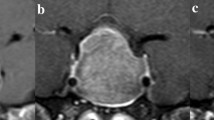Abstract
Introduction
Clinical presentations of prolactinomas are quite different between genders. In comparison with women’s prolactinoma, those in men showed predominance of large tumors with high prolactin (PRL) levels. This preponderance could be attributed to a greater proliferative potential of the tumors.
Differences in magnetic resonance imaging (MRI) signal at diagnosis have not been yet clearly evaluated.
Methods
We conduct a retrospective study comparing MRI signal intensity (SI) on T2-weighted images (T2-WI) between 41 men and 41 women to investigate whether or not men prolactinoma present specific features.
Results
In addition to the size of the adenoma and PRL levels (P < 0001), prolactinomas in men also exhibit differences from those in women in signal on T2-WI on MRI (P < 0001). Women’s prolactinomas are mostly of high SI on T2-WI while men’s prolactinomas exhibit a more heterogeneous pattern of SI on T2-WI. Prolactinomas presenting with low SI on T2-WI are almost exclusively encountered in men.
Conclusions
Presence of T2-WI hypointensities in pituitary adenoma can be predictive of a different subtype of prolactinoma almost encountered in men and possibly translate the presence of spherical amyloid deposits, in agreement with the literature.

Similar content being viewed by others
References
Daly AF, Rixhon M, Adam C et al (2006) High prevalence of pituitary adenomas: a cross-sectional study in the province of Liege, Belgium. J Clin Endocrinol Metab 91(12):4769–4775
Gillam MP, Molitch ME, Lombardi G, Colao A (2006) Advances in the treatment of prolactinomas. Endocr Rev 27(5):485–534
Schlechte A (2003) Clinical practice. Prolactinoma. N Engl J Med 349(21):2035–2041
Ciccarelli A, Daly AF, Beckers A (2005) The epidemiology of prolactinomas. Pituitary 8(1):3–6
Colao A, Sarno AD, Cappabianca P et al (2003) Gender differences in the prevalence, clinical features and response to cabergoline in hyperprolactinemia. Eur J Endocrinol 148(3):325–331
Nishioka H, Haraoka J, Akada K, Azuma S (2002) Gender-related differences in prolactin secretion in pituitary prolactinomas. Neuroradiology 44:407–410
Nishioka H, Haraoka J, Akada K (2003) Growth potential of prolactinomas in men: is it really different from women? Surg Neurol 59:386–391
Delgrange E, Trouillas J, Maiter D et al (1997) Sex-related difference in the growth of prolactinomas: a clinical and proliferation marker study. JCEM 82(7):2102–2107
Vroonen L, Jaffrain-Rea ML, Petrossians P et al (2012) Prolactinomas resistant to standard doses of cabergoline a multicenter study of 92 patients. Eur J Endocrinol 167(5):651–662
Raverot G, Wierinckx A, Dantony E et al (2010) Prognostic factors in prolactin pituitary tumors: clinical, histological, and molecular data from a series of 94 patients with a long postoperative follow-up. J Clin Endocrinol Metab 95(4):1708–1716
Osborn A, Preece M (2006) Intracranial cysts: Radiologic-pathologic correlation and imaging approach. Radiology 239(3):650–664
Pierallini A, Caramia F, Falcone C et al (2006) Pituitary macroadenomas: preoperative evaluation of consistency with diffusion-weighted MR imaging-initial experience. Radiology 239:223–231
Iuchi T, Saeki N, Tanaka M et al (1998) MRI prediction of fibrous pituitary adenomas. Acta Neurochir 140:779–786
Mahmoud O, Tominaga A, Amatya V et al (2011) Role of PROPELLER diffusion-weighted imaging and apparent diffusion coefficient in the evaluation of pituitary adenomas. Eur J Radiol 80:412–417
Levine S, Ishaq S, Nanda A et al (2013) Occurence of extensive spherical amyloid deposits in a prolactin-secreting pituitary macroadenoma: a radiologic-pathologic correlation. Ann Diagn Pathol 17:361–366
Bakhtiar Y, Arita K, Hirano H et al (2010) Prolactin-producing pituitary adenoma with abundant spherical amyloid deposition masquerading as extensive calcification. Neurol Med Chir 50:1023–1026
Sung C, Suh Y, Da Lee K (2008) Extensive spherical amyloid deposition of pituitary adenoma presenting as pituitary apoplexy. Clin Neurol Neurosurg 110(4):424–425
Hassan T, Ikeda H, Yoshimoto T (2003) Salmon Roe-like amyloid deposition in a prolactinoma: a case report. Brain Tumor Pathol 20(2):89–92
Wiesli P, Brändle M, Brandner S et al (2003) Extensive spherical amyloid deposition presenting as a pituitary tumor. J Endocrinol Invest 26(6):552–555
Martin S, Lefton D, Pinto R et al (2002) MR imaging characteristics of amyloid deposits in pituitary adenoma. AJNR 23:368–370
Sakai K, Tsutsui T, Sonobe H et al (1999) MRI of pituitary adenoma with extensive amyloid formation. Neuroradiology 41:358–359
Kitamura K, Nakayama T, Ohata K et al (2011) Computed tomography and magnetic resonance imaging appearance of prolactinoma with spheroid-type amyloid deposition. J Comput Assist Tomogr 35(2):313–315
Gul S, Bahadir B, Dusak A et al (2009) Spherical amyloid deposition in a prolactin-producing pituitary adenoma. Neuropathology 29:81–84
Mori H, Mori S, Saitoh Y et al (1985) Growth hormone-producing pituitary adenoma with crystal-like amyloid immunohistochemically positive for growth hormone. Cancer 55:96–102
Hinton D, Polk R, Linsc K et al (1997) Characterization of spherical amyloid protein from a prolactin-producing pituitary adenoma. Acta Neuropathol 93:43–49
Rasmussen C, Larsson SG, Bergh T (1990) The occurence of macroscopical pituitary calcifications in prolactinomas. Neuroradiology 31:507–511
Carapella C, Pompei P, Mastrostefano R et al (1983) Calcified pituitary adenoma associated with severe hyperprolactinemia. J Neurosurg 59:871–874
Tanriover N, Kucukyuruk B, Hatipoglu E, Comunoglu N (2014) Pituitary stone: a case report and review of the literature. Turk Neurosurg 24(6):967–973
Bancroft J, Gamble M (2008) Theory and practice of histological techniques 6th edition. Churchill Livingstone, Elsevier
Ethical standards and patient consent
We declare that all human studies have been approved by the comité d’Ethique hospitalo-facultaire du CHU de Liège, Belgique and have therefore been performed in accordance with the ethical standards laid down in the 1964 Declaration of Helsinki and its later amendments. Patient consent was waived due to the retrospective nature of this study.
Conflict of interest
We declare that we have no conflict of interest.
Author information
Authors and Affiliations
Corresponding author
Rights and permissions
About this article
Cite this article
Kreutz, J., Vroonen, L., Cattin, F. et al. Intensity of prolactinoma on T2-weighted magnetic resonance imaging: towards another gender difference. Neuroradiology 57, 679–684 (2015). https://doi.org/10.1007/s00234-015-1519-3
Received:
Accepted:
Published:
Issue Date:
DOI: https://doi.org/10.1007/s00234-015-1519-3




